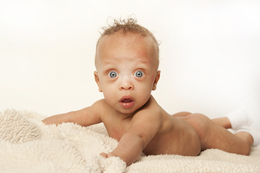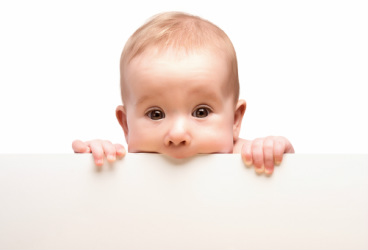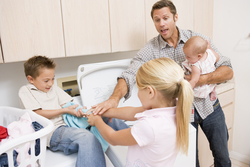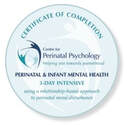|
It was in couples training that I was told this odd but evident truth. The reason why kids play up in the back of the car is that no one is watching them. The parents are there but they are facing forward, not looking at the kids, so the kids are ‘un-regulated’. When parents look at their children they are assisting the child’s regulation. Regulation? Unregulated? What the??? Regulation describes how we modulate our behavoiur according to our emotional mood and the demands of the environment. It is the process by which we balance the needs of our inner state with the demands of the outer world. For example, Sitting in a church reverently requires a high amount of regulation - inhibiting the desire to drink, cross your legs, make a comment, yawn or giggle. All behavioural impluses need to be held back. Regulation also occurs when we have to alter our emotional state. For example perhaps we have been upset by a nasty comment by someone, say, a work colleague. However, to continue working we need to put on a happy face for the next client even when we would rather spill out our annoyance and how upset we are with our insensitive colleague. So we withhold our impulse to moan about the injustice, or better still, we rationalize it out of existence by telling ourselves they didn’t mean it and it had nothing to do with us anyway. In the last example of rationalizing our way out of an upset mood, we can see that self regulation is self control that goes beyond holding back and restraining impulses. It includes improving or modulating our mood to meet the situation. The is the sophisticated self regulation that is needed in adult relationships. As adult there are times we need to completely ignore our needs in order to meet the needs of another. Self regulation, as the term implies, is done for the self by the self. The inhibition or modulation is self governed, we don’t need another to tell us what to do or how to do it or even when to do it, we just know. But how do we know? Well, somewhere somehow over many years we learnt what was right and wrong and what was needed and when it is needed. Often times we developed a little voice or inner sense that directs this. Usually we were taught regulation by our parents and this voice becomes part of us. Neurologically, however, we need developed frontal lobes to enable self regulation. This is because it is the frontal lobes that ‘oversee’ our behaviour and enable the inner and often reflexive dialogue that guides us to do the right or appropriate thing. The frontal lobe area of the brain lies just behind the forehead. It heads up the ‘executive function’ area of the brain and is, neurologicly, the hallmark of maturation. In human terms, self regulation allows us to be social beings and have mature relationships with others. Many don't quite make it there, but that's a whole other topic. But the Frontal lobes aren’t fully developed until the young adult is 24. So self regulation isn’t really complete until that age either. However, it builds and builds over the years and as the brain matures. The new born is completely regulated by the parent. The toddler needs a lot of regulation that slowly lessens as they embody enough self control to sit in a classroom. Then as the child grows they ideally learn increasingly complex ways of self regulation, changing from the child who couldn’t not react when someone hurt them to an adult who could choose not only if they react but how and when they react. But it takes time, and it takes repitition and it also takes an adult who is a good teacher. One powerful tool of regulating another is with the use of our eyes. We use our eyes to indicate attraction, aversion, fear and punishment. The sensitivity a child has to the eyes of another is evident very early in life. Have you ever looked at a baby and noticed how they turn away after you have been cooing or ga-gaing at them for a while? Some of the older ones will even push their hand out or cry if you continue to stare at them. This is because eye contact is very stimulating to a small child who has a low capacity for self regulation. They can’t switch off or move away from the person starring at them, they can learn to look away and protest. While small babies of about 4 months will stare and stare at their mums, older babies who are becomming more aware of strangers and their separate existence from mum will develop and averson to prolonged gazes, especialy those from strangers. They will also be acutely sensitive to the emotional valance of the gazers face. Experiments looking into the effect of maternal depression on infants called the ‘still face paradigm’ observed that infants would initially try to engage the still faced experimenter, but become increasingly distressed the longer the still face remained staring at them. Eye contact is very important. It is at the essence of human interaction. We don’t trust people who won’t look us in the eye, and we especially don’t trust our partners not looking at us when we ask them why they were out so late. Dogs are regulated by their masters eye contact, and direct eye contact also says “ I am the boss’ when we are admonishing children. How many times does the disciplinarian demand "look at me when I am speaking to you.” But eye contact isn’t all about truth telling and disciplining. Eye contact is an essential part of bonding between babies and parents and pair-bonding between couples. Its the look of love that keeps relationships alive and the loving looks that help our children feel seen and loved. With over 60% of the brain devoted to visual pathways, we can’t underestimate looking or the effect of looking. While most people have no problem gazing lovingly at their infants, many people forget how important a kindly look is to a child. We use our look to let a child know when they are in trouble. In this way the eyes are an important tool of early regulation. Animals do this, glance at a infant who is straying too far, and scowl at them if they are getting out of line. But often we forget the loving looks that say, "I see how special you are." How we look at our children can affect how they feel, the sense of who they are and how well they learn to regulate themselves as adults. If you don’t believe in the power of the look, try not looking at your partner for a while and see what happens. Alternately stare your child down and watch how uncomfortable it makes them. If you really want to see the effect of your gaze on your child, try scowling at them every time they ask your for something. Note their mood. Now spend an equal amount of time looking at them with 'soft' and accepting eyes. Tell me there isn't a difference? So how does this connect with bad kids in the back of the car? Little kids rely on their parents for regulation, They can’t do self regulation very well. When we are driving we are in close proximity to our child but not looking them this is instinctually confusing so they go a little crazy sometimes. If we are around, something inside a small child expects us to be watching them so they relax just enough to let all the pent up stuff come out. They are, in a way, saying, 'tell me what to do with all this'. They are wanting us to help them regulate, to help them control the stuff that is confusing them. This is why some kids only have a tantrum when mum is around, or only want attention when the phone rings, or only play up when they are in the back of the car. We are there, but we are not there. Children know, at a level, when we are present to them and not. In the same way that we know if our partner is ‘not there’ when they talk to us but are preoccupied, kids can sense when we are tied up with something other than them. The smaller the kid the more dysregulating this can be. So, what, I can hear you ask, is the solution? Well, other than sticking an image of your staring face on the back of the seat, or lodging a parent in a seat facing the kids, not a lot I am afraid. However, you can get more in touch with how your eyes regulate your kids when you are not in the car together. First, get aware of this phenomena. Notice what you do with your eyes. Are you guilty of only looking right at your child when they are playing up? Can you find yourself engorssed in organic moments of gazing upon your child with pride or admiration? Are they even aware of this (or do you, like many frazzled parents, only gaze lovingly and quietly on your sleeping child)? Do you stop and look at your child when they ask you something or are you always distracted by something else so that by the time your child has your attention your look is one of exasperation or exhaustion? Then, once you have seen what you are doing with your looks, focus on employing more ‘looks of love.’ Spend small moments of your day, little snippets where you join with your child in doing something they want to do. You might be watching them doing something or you might be directing your gaze to the thing that they are doing. These are moments of ‘joining’ that give a child the sense that you are ‘there’. You are also helping them with the beginnings of self regulation. Not only using your looks to tell them when they are doing something wrong, but using your looks to let them know they are loved and cherised. Many parents protest at this point that their child sometimes feels like a bottomless pit demanding endless amounts of attention and they worry that once they start doing something like this that their child will want more and more. Remember when I mentioned how sustained eye contact can upset a baby? Well many children will not enjoy sustained attention after a while either. There is a natural eb and flow to a child’s activity that drives activity and rest, being in contact and withdrawing. Depending on the age of the child, if the contact your child has with you is nourishing they will get full and satisfied and naturally withdraw into their own world or activity. However, if you are not present... if you are not truly with them in that moment it will be like a fast food grab to them, quick, hurried and not really satisfying. Additionally, If there has been a long pattern between you of the child being frustrated in attempts to get your attention they may need more at first and may seem insatiable. If your child flits from one thing to another desperate to maintain your attention and this continues for some time (days, weeks) then it could be something else is going on there. Usually, however, this ‘quality time’ need only last a few moments to be effective enough to let your child know you are there and interested in them. When my children were young I found this moving in and being with them to be the most effective behavioural management strategy. I tried the positive reinforcement of good behavoiur with disastorous results. Seeing my two close in age pre-schoolers playing I would grab the opportunity to ‘positively reinforce’ their cooperative play “Oh, look at you two playing so nicely together.” I would exclaim. This well played move was all too often met with a rapid backfire. Instantly they would stop their cooperative play and go silly. What happened? They had my attention, I was doing the positive reinforcement like the book said. This was supposed to encourage more of the same behaviour, but it didn’t.
Problem was, it was contrived. They didn’t need me there buttering them up from accross the room. They we happy in what they were doing and who knows, maybe they picked up on the calculated tension in my pretence. After all, the truth was while I did appreciate they were playing nicely together my instinct was to ‘let sleeping dogs lie’ and take a moment to myself where I wasn’t needed to negotiate a fight. I was going against my instincts and the natural flow and intercepting with a fabrication. What I did find that prevented fights and moments of discord and playing up most effectively was the moments where one was playing and I joined them in that moment. Looking at what they were doing, playing along for a while, gazing at them, and then back at their activity with interest, love, presence and intention to really be there with them in that moment. And it really was only was a moment, maybe 2- 3 minutes was all it took before I could gently slip back to my adult world and duties, leaving a satisfied and ‘met’ little person to return to their game. The flow on effect was a child who had had a gulp of satisfying attention, and less need to gain a giant fast food grab by taking a swipe at a siblings toy or throwing something to see what I would do. When I used my look for love, and at other times when perhaps I might just look at them and smile with warmth and love I was actively balancing my scolding looks (after all, how many times a day do you need to tell off an active toddler boy?) with loving looks. In doing this I was balancing the regulation of self control (or what eventually one day became self control) with the regulation of the child as feeling loved, valued and ‘seen’. The look of love, try it for yourself, with awareness and let me know how you go. Posts regarding integrative medicine, human behaviour, psychotherapy, gestalt therapy, bio-chemical disorders; pyrrole, methylation, copper and zinc imbalances, child behaviour, family relationships, parenting.
0 Comments
Leave a Reply. |
AuthorClarissa Mosley Categories
All
Archives
November 2022
|



 RSS Feed
RSS Feed



